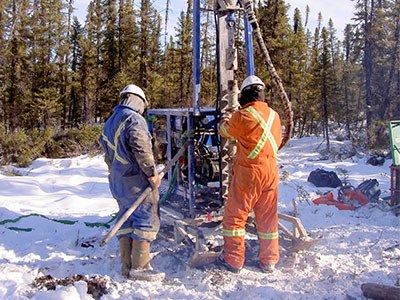The Ontario government is hoping to create some Kumbaya moments with the establishment of a Ring of Fire development corporation to bring miners, First Nations, and Ottawa together to kick-start momentum in the dormant exploration camp.
Northern Development and Mines Minister Michael Gravelle announced Nov. 8 that the province was “taking action” with a new entity to design, build, finance, and operate transportation infrastructure to access this globally strategic series of chromite deposits and unlock the region's untapped mineral potential.
“This will bring people together,” said Gravelle. “This will allow us to make decisions related to the right transportation infrastructure decisions.”
The Wynne government has come under criticism by Opposition members and Northern leaders over its lack of progress on an action plan to help develop the rich deposits in the James Bay lowlands. The move comes two months after a provincial tribunal ruling created uncertainty on whether the Ring's biggest mining player, Cliffs Natural Resources, would walk away from its potential $3.3 billion mine and mill investment in Ontario.
Last September, Ontario's Mining and Lands Commissioner denied the Ohio mining giant overland access to its Black Thor chromite deposit atop the mining claims of a rival company, KWG Resources. Cliffs has put the brakes on at Black Thor over stalled talks with the province concerning miningrelated infrastructure, power rates for a proposed Sudbury refinery, and approval on the environmental assessment process. The company is also re-evaluating its $4-million per month expenses on the project.
Now Queen's Park is taking a hurry-up approach.
“We're going to hit the ground running,” said Gravelle.
Invitations were dispatched the day before Gravelle's announcement to Prime Minister Stephen Harper, the mining companies involved, and the chiefs of the Matawa tribal council to become corporation partners.
“I'm optimistic there will be responses rather quickly from all quarters of those we reached out to,” said Gravelle.
Each of the main mining players – Cliffs, KWG and Noront Resources – have individual road or rail plans to move ore out of the region. Gravelle acknowledged the tribunal's decision and the “divergent interests” among the mining companies prompted the government to take action. As to the scope, structure, and timelines involved with the corporation, Gravelle didn't make that clear.
That's up to the participants, he said, adding there are successful examples of development models elsewhere, namely the Sierra Yoyo Desan road project in northern British Columbia.
In its fall economic statement, the Wynne government promised to spend $35 billion for infrastructure over the next three years.
While the Quebec government is funding a $20-million pre-feasibility study for a potential 800- kilometre railway from the Labrador mining trough to the port of Sept-Iles, Gravelle said Ontario is prepared to make a “significant investment” in the Ring, but Ottawa needs to provide matching dollars. In Premier Kathleen Wynne's appeal to Prime Minister Harper, she outlined the total Ring of Fire infrastructure costs as between $800 million and $1 billion, and fixed a price tag of $1.25 billion for a road north. The economic returns should be in the order of $60 billion, she said in her letter.
“The Ring of Fire presents an historic, multigenerational opportunity to transform the region, create thousands of jobs, and enhance the future economic opportunity of Canada.”
Cliffs Natural Resources was encouraged by the province's initiative.
“Without infrastructure, none of the projects currently proposed or imagined in the region will become a reality, so it is important that we move swiftly to establish that infrastructure in a way that is sustainable, responsible, and benefits local communities,” said the company in a statement.
KWG Resources, a Toronto junior miner with the only staked access corridor to Ring, was invited to the table.
CEO Frank Smeenk was “delighted” to be asked to participate, adding the government's proposal is the same model that KWG has discussed with First Nation leaders.
KWG has been studying the logistics of moving Ring of Fire chromite out by rail. The company supports an inland port authority concept being championed by the unions of the Ontario Northland Transportation Commission to make the publicly-owned railroad the exclusive carrier in the Ring.
Moe Lavigne, KWG's vice-president of exploration, was more cautious.
“We need to see what this economic development corporation will look like, who will sit at the table, and will it have any teeth before we can ascertain whether it can deliver on its promise. Critical in this is the presence of the federal government.”
For Thunder Bay Mayor Keith Hobbs, the news was long overdue. His city, 600 kilometres south of the Ring, stands to benefit from the mining spinoffs.
“We've been hearing this for the three years that I've been mayor and it's time to start putting some shovels in the ground. Build a road, build rail, put power up there, do something for crying out loud. We're as frustrated as anyone else.” Sudbury Mayor Marianne Matichuk applauded Gravelle, and herself, for the creation of the corporation based on a motion she tabled calling on Queen's Park to resolve issues on a transportation corridor.
“I am pleased that Minister Gravelle took my lead and stepped up by getting everyone to the table to resolve the outstanding issues,” she said in a statement.
Sudbury was named by Cliffs as the future site for a ferrochrome refinery to process chromite ore coming from its Black Thor project.




